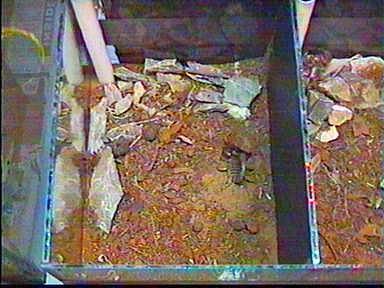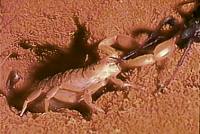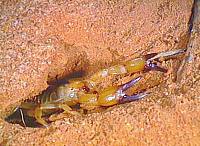 Name: Inland or Desert Scorpion Name: Inland or Desert Scorpion
(Urodacus yaschenkoi)
Care Information:
Handling Scorpions:
Excessive handling of scorpions is not recommended as this tends to create stress, which can cause a gravid female to resorb her young. Handle scorpions gently by grabbing their tail with tongs or tweezers and offer support to the body when lifting. You can get them to move into another container easily by ushering them in.
Remember the end of the tail of the scorpion has the sting, which contains venom. Australian scorpions are not considered dangerous to humans although a possible reaction as sometimes occurs with spiders may result, hence be careful. A sting causes localised pain that can be quite bad and could last up to 12 hours.
Don't expect to be able to handle your scorpion at all, its to be avoided as much as possible. I have also witnessed this species spraying venom as a fine mist when agitated, which is also a known behavior for some overseas species. Don't risk getting venom in the eye or any cuts/abrasions.
Housing:
In the wild this scorpion digs a burrow up to 1 meter deep depending on how arid the location is. The scorpion seeks a subterranean depth where moisture and temperature are suitable for its existance. In captivity there are numerous ways of keeping this scorpion, depending on what the keeper is aiming to achieve. You may wish to reproduce the natural environment as closely as possible or you may wish to create an environment which gives better viewing without hampering your scorpions health. Housing can be anything from which the scorpion cannot escape such as an icecream container or for best viewing a glass aquarium.
Scorpions can be kept individually in jars, although this is not recommended, as it doesn't allow natural activity for the scorpion. Nevertheless if you wish to see certain activities then a jar kept scorpion can be good for viewing behaviour, such as a scorpion stinging and consuming it's prey or cleaning itself. Possibly after seeing these activites you may feel a bigger house would be better for your scorpion. If you choose to place your scorpion into a jar for a while, half fill the jar with damp soil, preferably desert sand or some similar coarse sand. Pack the sand in nice and hard, so the scorpion may dig a shallow burrow if it desires. Place a lid on top with holes punched in to keep humidity high, this will help simulate the conditions at the base of the scorpions burrow, and the scorpion will be quite happy like this. Jar kept scorpions are often the easiest to feed also. Keep the scorpion at between 20-25C and give it a day/night cycle.
Realistic Setting
For a realistic setting and the most natural behaviour a good depth of sand is required. Use as much sand as you can get into the tank without the scorpion climbing out, leave at least 12cm from the top for a good safety margin. Use dampened sand, packing it down hard bit by bit so the soil is compact and not loose or it may collapse onto the scorpion. Once you have packed the soil hard to the depth you require you can add whatever things you like for appearance. If you are using a deep sand setup then push a tube or pipe into the sand in each corner of the tank reaching about 20mm from the base(do this before filling with sand).
 The idea is to create a moisture gradient from slightly damp at the base to dry at the surface. The idea is to create a moisture gradient from slightly damp at the base to dry at the surface.
Introduce your scorpion/s to the tank. Sometimes they may need encouragement to burrow or you may prefer to have them burrow at a particular place, like at the front of the tank. By placing a clear plastic container over the scorpion you can force it to dig in the spot of your choice. You may dig a slight hole yourself to help the scorpion get started. Once the scorpion starts digging it will continue to do so and it wont require further assistance. It's not necessary to have a lid on the tank and in fact this tends to increase humidity too much so is not recommended. Scorpions cannot climb glass or jump so there is no danger as long as people don't put their fingers into the tank.
Click here to see a burrow being excavated.
Click Here to see a diagrammatical representation of a burrow.
Feeding
Scorpions are largely insectivorous, hence crickets are a good source of food. Beware feeding insects that may be carrying poisons from insecticides etc. Feed as much as the scorpion chooses to eat. These scorpions sit and wait at the burrow entrance, when something walks past they will come out and nab it.
Q: How many scorpions can I keep in one tank?
I have found the inland scorpion to be reasonably tolerant of others of it's own species. Generally scorpions are solitary creatures and don't get on too well together. It is my experience that young scorpions tolerate each other far more than older scorpions. The inland scorpion is less problematic here and more can be kept together as once they have their own burrow they are unlikely to interact. Scorpions kept in a situation where they cannot burrow are more likely to kill each other as the possibility of interaction increases. A 2 foot aquarium could easily house 4 adult scorpions in my experience.
Q: How do I sex my scorpion?
This is a very difficult thing to do with respect to the species I'm discussing here. As juveniles it's generally impossible to sex the scorpion. As adults it's not much easier, the male may have a very slightly longer fifth tail segment than females. If you can see underneath the scorpion you will notice a plate located at the sternum, this plate is called the genital operculum. The genital operculum is usually split longitudinally in males and fused in females. Also with very keen eyesight you may notice 2 tiny projections protruding from underneath this plate at the rear, these are genital papillae and are only present in males. Sorry , but that's about it for sexing this species.
Watch this page for updates, Ill post images to help with sexing and ventral anatomy in the near future.
Some Basic Scorpion Biology
Scorpions are arachnids like spiders, ticks and mites. They are believed to be one of the oldest living arthropods and were possibly the first to colonise land around 450 million years ago. For a basic structural morphology Click Here.
Scorpions are long lived for arthropods, the Inland scorpion discussed here reaches sexual maturity at the age of 5 years, and is generally thought to live 2-5 years after that. Females have a gestation period of approx 18 months and give birth to around 20 live young. The mother looks after the newborns until they shed their skin for the first time about 6 weeks after birth. The young scorpions then leave mums burrow and dig their own burrows.
 Male scorpions search for females during warm weather for the coupling which is achieved externally and very carefully.
Male scorpions search for females during warm weather for the coupling which is achieved externally and very carefully.
Mark A.Newton
The information on this page is the copyright of Mark A. Newton and is not to be copied or displayed elsewhere on the internet without permission of the author.
|
|


 Name: Inland or Desert Scorpion
Name: Inland or Desert Scorpion